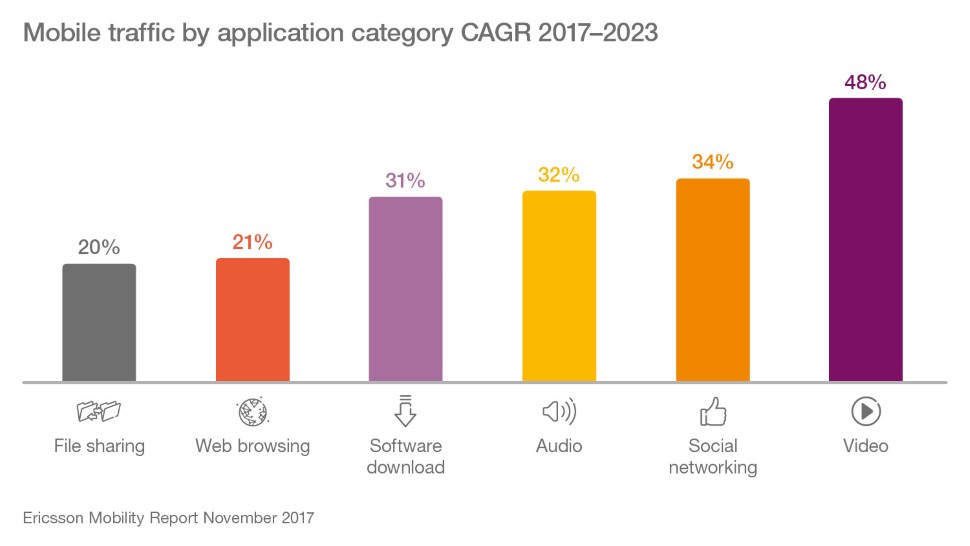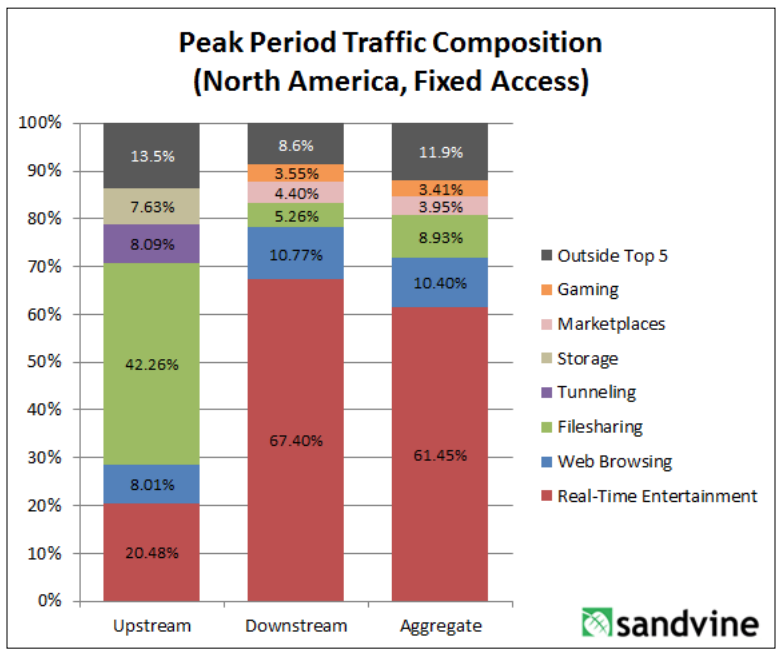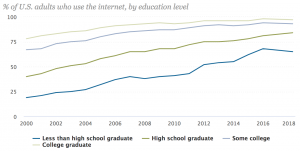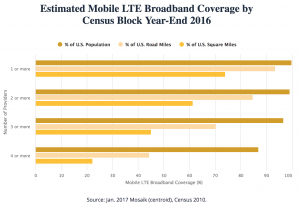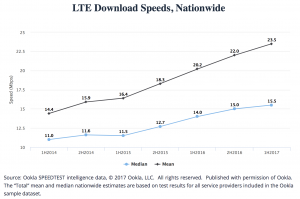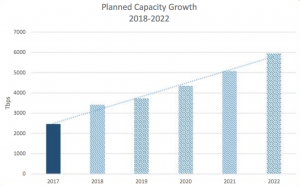Media/Internet Time Allotment
Overall Media Allotment
src:
Statista, accessed May 2018
citing: info not available (likely eMarketer)
*
CC’s Note: eMarketer tracks the way people spend their time with media, showing comparison between desk/laptops, mobiles, non-streaming TV, radio, print
src: eMarketer, Sep 2017
via InsideRadio, Oct 2017
“EMarketer: Adults Spend Half Of Daily Media Usage On Digital”
*
UK Adults’ media time has plateaued
“The way that people consume media will continue to change,” said eMarketer’s UK analyst, Bill Fisher. “Many traditional habits are simply transitioning over to digital devices and platforms, while digital-only habits continue to proliferate. However, what’s apparent from this forecast is that UK adults have reached a plateau. While the media mix may ebb and flow, and it will increasingly flow toward mobile, adults’ media consumption capacity has reached its peak.”
*
src: eMarketer
small thumbnails retrieved 5/14/18
permalinks (data restricted by paywall)
Average time spent per day with internet by adults in China by Device 2014-2020
Average time spent per day with major media by adults in China 2014-2020
*
In 2017, daily time spent with digital media among adults will top 3 hours in Japan (3 hours 5 minutes) and South Korea (3 hours 26 minutes). Those in India will average less than half that time (1 hour 18 minutes), with digital accounting for just under one-third of total daily time spent with media.
src:
eMarketer, June 2017
*
Daily time spent on social networking by internet users worldwide from 2012 to 2017 (in minutes)
src:
Statista, accessed May 2018
citing: untracked
*******
Mobile Time Allotment
FIGURE A3.1
Traffic Daily Profiles of the Five Major mobile Applications in North America (2020)
Figure A3.1 shows the daily profiles of the five major mobile applications in North American Region (NAR), namely, streaming (audio and video), computing (cloud processing, office productivity, other mobile applications), storage (media sharing, backup and device synchronisation), gaming (casual, interactive or emerging applications), and communicating (voice, video, e-mail and M2M). All these represent human behaviours and they are similar across geographies.
src:
International Telecommunication Union, July 2015
“Rep. ITU-R M.2370-0: IMT traffic estimates for the years 2020 to 2030”
P.40-41
citing:
Source: Bell-Labs, Alcatel-Lucent, 2015.
[CC’s note: Haven’t been able to track this down]
*
Mobile traffic distribution over different applications
Contrast with voice usage
[Data here: Ericsson-Minutes-of-voice-monthly-2010-2023.xls]
src:
Ericsson, Accessed May 2018
Traffic Exploration [interactive data tool]
*
Sandvine, a Canadian network intelligence firm, tracks traffic composition. They’ve published a few reports with the current and previous year’s data, but I haven’t found anything more longitudinal. The reports describe peak period traffic composition across the following categories: real-time entertainment, marketplaces, storage, filesharing, web browsing, gaming, social networking, communications, and other. There are separate charts for mobile and fixed access.
from
“2016 Global Internet Phenomena: Latin America and North America”
from
“Global Internet Phenomena Report: 2H 2013”
CC’s Note: I’ve not been able to find a more recent version of the report. Sandvine was acquired recently, although the report author is still with the company. Could contact him to ask. Dan Deeth: ddeeth@sandvine.com
*
Comscore is tracking differences between desktop and mobile internet usage.
CC’s note: Not sure if historic data are aggregated, but here’s a sample of recent statistics (covering US, Canada, France, Germany, Italy, Spain, UK, Argentina, Brazil, Mexico, India, Indonesia and Malaysia)
Smartphones are the dominant platform in terms of total digital minutes, in every region Comscore examined.
Most pronounced in India – 89% total minutes
Least noticeable in Canada – 43% of total minutes (42% desktop, 15% tablet)
US: 60% (30% desktop, 10% tablet)
Mobile minutes are overwhelmingly spent with apps – over 80%
Top apps (everywhere, in various rankings) include:
Google Search, Whats App, Facebook, YouTube, Google Play, FB Messenger
Three largest categories where digital time is spent:
Multimedia (includes several large video streaming services), Social Networking, Instant Messengers
Looking specifically at mobile digital time, the top four categories are:
Entertainment, Social Media, Instant Messaging, and Games
On average, Social Media has the largest average share of mobile minutes, but Entertainment is larger in the US and Canada.
Among Social Media apps, Facebook, totally dominates, followed by Instagram, then Snapchat, then Twitter (Twitter’s share is tiny).
Among Messaging apps, WhatsApp totally dominates, then Facebook Messenger (less than half), then WeChat (very small share).
The report includes visualization of platform preferences for certain categories. Business/Finance (which includes banking) shows the most even split between mobile and desktop reach. In the majority of markets, retail is heavily biased toward mobile. News/Information is overwhelmingly biased toward mobile.
(shown for UK and India – both show a fairly even split between desktop and mobile for banking minutes).
The report also includes visualization of subtle seasonality in certain categories of content (shown for UK and Brazil).
src:
Comscore, 2018
“Global Digital Future in Focus”
Ericsson: 5G impacts on sports events
Alongside November 2017’s Mobility Report, Ericsson offered some speculations on the effect 5G mobile service might have on sporting event spectators.
Excerpts:
Key findings
Growth in mobile traffic at events can be attributed to changes in user behavior, especially among younger people
Spectators now mainly share or stream live videos and engage with social networks at events, as well as increasingly creating and uploading their own content
Augmented reality (AR) and virtual reality (VR) technologies can enhance visitors’ and remote spectators’ experience of events, making them available in new ways
4G systems will continue to support event visitors with services, but in the near future, 5G technology will have the capability to transform their experience
At future events and connected venues, with high traffic density and increasing use of demanding services such as AR and VR, proactive management and automation will be essential to meet committed service levels
A range of services may be included in 5G showcases, allowing venue visitors to turn from spectators into participants and enabling them to:
Watch events from different viewpoints with interactive control
Access multiple cameras filming an object to achieve a 3D view
Experience sports activity from the perspective of the athlete via mini-cameras
Enjoy an in-stadium experience outside the venue through haptic or tactile feedback
View live holographic projections of athletes
Integrate supplementary content into their live streams
See athlete, event or venue statistics superimposed on their device display
Analyze and display performance data through sensors embedded in sports equipment
Receive real-time information on factors such as the speed and location of a ball
View overlay and substitution content, for example, explaining rules, giving more details and personalizing the experience
src:
Ericsson, Nov 2017
“From spectators to participants”
Proliferation of cell sites and light bulbs
NOTE:
This chart reflects production of large incandescent lamps, which include the ordinary electric-light bulbs for residential, commercial, and industrial use. This category excludes miniature lamps such as those for motor vehicles, flashlights, and Christmas trees. (Bright, p.5, Note 2). Production of other types of lamps (miniatures, photofloods, etc) seem to’ve been fairly low in the first three decades of lamp production (1891-1919), but began to ramp up soon thereafter, certainly by 1939 (figures reported in Bright, p. 10), and by 1945 these other categories of lamps accounted for about 36% of total lamp production (calculated based on figures reported by the FTC in 1980, p.34).
DATA
Cell sites in service
1986 1,531
1996 30,045
2006 195,613
2016 308,334
src:
CTIA, 2017
“Wireless Snapshot 2017”
Light bulbs shipped (thousands)
1891 7,500
1899 25,320
1909 66,776
1919 224,713
src:
MIT Studies of Innovation, 1949
Arthur A. Bright
“The Electric-Lamp Industry: Technological Change and Economic Development from 1800 to 1947”
p.4, Table I: The Production Of Large Incandescent Lamps In The United States 1879-1945
NOTE:
Data from these two sources is aggregated in CC’s Excel file: cell-sites-vs-light-bulbs.xls, which includes additional years of data (through 1945) for the light bulb industry, as well as calculated rates of growth.
*
Additional source for light bulb production
Federal Trade Commission, February 1980
“Staff Report on the Development and Structure of the U.S. Electric Lamp Industry”
Excerpts:
Total volume of light bulb industry
1912 90.8 million
1926 478.9 million (527% increase from 1912)
p.103
| Comparison of 1945 and 1974 Shipments of Various Types of Electric Lamps [thousands of units] |
|||
| Type of Lamp | 1945 shipments | 1974 shipments | Percentage change |
| Photographic | 36,447 | 2,406,332 | 6,502.3 |
| Large incan. | 794,402 | 1,532,039 | 92.9 |
| Miniature* | 337,325 | 964,016 | 185.8 |
| Fluorescent | 42,781 | 284,529 | 561.1 |
| Total | 1,250,689 | 5,395,942 | 331.4 |
p.34
*Of the 964,016 Miniature lamps shipped in 1974, 665,208 were used in automotive applications. (p.43)
citing:
U.S. Department of Commerce,_c: Bureau of the Census, Current Industrial Report: Series MQ-36B(74)-5, Electric Lamps, 1975; and U.S. Department of Commerce, Bureau of the Census, Facts for Industry: Electric Lamps, 1946.
Table 111-1 shows the U.S. value of shipments, exports, and imports in SIC 3641 for the years 1967 to 1973. During that time; imports never accounted for more than 6.79 percent of total domestic value of shipments while exports never accounted for more than 5.21 percent. When imports are added to value of shipments and exports subtracted from the whole, consumption can be found. Between 1967 and 1973, 93 percent of the total lamps consumed in the United States were manufactured in the U.S. In the same seven-year period, 94.8 percent of the lamps manufactured in the United States were used in the U.S.
p.38-40
***
OTHER BITS OF POSSIBLE INTEREST…
“Consumption Spreads Faster Today”
Chart shows historic penetration rates for new technologies – accelerating over time.
Includes electricity.
Other interesting excerpt:
At the average wage, a VCR fell from 365 hours in 1972 to a mere two hours today. A cellphone dropped from 456 hours in 1984 to four hours. A personal computer, jazzed up with thousands of times the computing power of the 1984 I.B.M., declined from 435 hours to 25 hours. Even cars are taking a smaller toll on our bank accounts: in the past decade, the work-time price of a mid-size Ford sedan declined by 6 percent.
src:
New York Times, February 2008
graphic src:
Nicholas Felton (not sure about data src, although many other version of this chart exist, so it must be widely available data)
And here’s an older version of the chart (1998), different illustrator, additional detail.
And another version, through 2010, which really emphasizes the acceleration of penetration rates.
*
U.S. Housholds by Type of Phone, 1900-2011
src:
Harvard Business Review, Nov 2013
graphic by:
Michael Degusta, MIT Technology Review
using data from Forrester, Knowledge Networks, Net York times, PEW, US Census
*
The History of the Light Bulb – US Department of Energy
Interactive timeline of light bulb technology
Light – Our World in Data
Price (1300 to current, UK), consumption (1700 to current, UK), and access (current, global) to lighting
Internet Connectivity and Infrastructure
Pew Internet/Broadband Fact Sheet
src:
Pew Research Center, Feb 2018
“Pew Internet/Broadband Fact Sheet”
*
FCC Fixed Broadband Deployment Map
See the source link for an interactive version of the map.
src:
FCC Fixed Broadband Deployment
Accessed April 2018
Note: Discussion of the FCC map and it’s latest version is available here. The latest map is based on 2016 data. FCC does not have an equivalent map for mobile broadband, although it does publish an annual report on mobile wireless competition.
*
20th Mobile Wireless Competition Report Quick Facts
src:
FCC, September 2017
20th Mobile Wireless Competition Report Quick Facts
A couple more interesting bits from the full report…

NOTE: MOU = minutes of voice use
[p.72]

Note: A “connection” is a paid subscription, equivalent to the number of ‘lines’ when discussing landline phone service.
[p.73]

[p.74]
Note: According to CTIA, there has been an approximate 57 percent growth in the number of cell sites over the last ten years (in 1986, there were 1,531 cell sites in service).
The report notes that, according to CTIA, the number of cell sites will significantly increase as the mobile wireless industry densifies and prepares for 5G. Also, because multiple cell sites can be co-located in the same “tower” site, the reported cell sites should not be equated with “towers.” The reported cell sites include repeaters
and other cell-extending devices (e.g., femtocells or distributed antenna systems).
A specialized communications tower industry has developed to provide and manage the
support structures for the cell sites. Today, there are more than 120 tower and DAS operators in the United States, and a majority of towers are now owned or operated by independent companies rather than by mobile wireless service providers.142 Independent tower operators own, operate and lease shared wireless communications and broadcasting towers, manage other tall structure sites (such as rooftops and water towers), and to a lesser extent, own and operate neutral facilities to host small cells and DAS networks for mobile service providers. [p.32]
src:
FCC, Sep 2017
“Implementation of Section 6002(b) of the Omnibus Budget Reconciliation Act of 1993, Annual Report and Analysis of Competitive Market Conditions with Respect to Mobile Wireless, Including Commercial Mobile Services”
*
[In the U.S.] Expected arrival time-frame for 5G roll out with decent coverage and availability in handsets:
early 2020s
(Although 2019 phones will be advertising capacity, even if there’s no network to connect to right away.)
“I believe that eventually consumers will pay for just one broadband connection, fixed and mobile. When I say 50M or more homes, I mean wireless substitution. I think you can draw a parallel with local telephone service and long distance. The long distance business evaporated. Similarly, today’s fixed and mobile broadband services will collapse into one. The cellular operators today are better positioned to take that market.” Peter Rysavy (wireless technologies consultant)
src:
Forbes, Sep 2017
“The Dawn Of 5G: Will Wireless Kill the Broadband Star?”
Ericsson (Nov 2017) has the same prediction for 5G, anticipating coverage for more than 20% of the global population (1 billion) by the end of 2023. First deployments are expected in 2019.
*
Submarine Cable Capacity
src:
Submarine Telecoms Industry Report 2017
[p.17]
*
Network World, Mar 2018
“Submarine cable boom fueled by new tech, soaring demand”
Excerpts:
Between 2013 and 2017, the subsea cable industry has added an average of 32 percent of capacity annually on major submarine cable routes.
SubTel Forum projects global submarine cable capacity will increase up to 143 percent between 2017 to 2022, and it also notes that a construction boom is already underway. Last year, 62,000 miles of submarine cable was added globally. This, after global averages didn’t crack 19,000 miles of added cable between 2013 to 2016.
According to TeleGeography, the international capacity deployed by companies such as Google, Facebook, Microsoft, and Amazon rose 14-fold between 2012 to 2016. … By investing in them, these mega-companies get them built faster. They also get a level of control over construction, maintenance and operation that’s ultimately more economical than becoming a paying customer on a telecom’s cable.
[It’s now cheaper to build systems with greater bandwidth. In 2013, new systems averaged 9 terabits per second (Tbps) — multiple systems planned for 2018 and 2019 will have capacities of 60 Tbsp. Tech advances are also eliminating costly and complex infrastructure layers, such as regen equipment. In addition, new cables can land directly inside multi-tenant data centers, rather than a traditional cable landing station (CLS) on the beach.]
*
Telegeography, Nov 2017
“A Complete List of Content Providers’ Submarine Cable Holdings”
This article lists cables owned or strongly supported by Amazon, Facebook, Google, and Microsoft.
Excerpt:
The amount of capacity deployed by content providers has outpaced all other customers of international bandwidth in recent years. Between 2012 and 2016 the amount of international capacity deployed by companies like Google, Facebook, Microsoft, and Amazon has risen 13-fold to 179 Tbps. (In contrast, international capacity deployed by all other operators only rose threefold, to 272 Tbps).
Content providers prioritize some submarine cable routes more than others in their network deployments. Between 2012 and 2016, content provider demand was the strongest across the Atlantic where capacity rose at a compound annual rate of 66 percent to 42 Tbps.
And as such, the largest content providers have built U.S.-centric network architectures. Their investments on systems directly connecting Europe to Asia are almost non-existent, in comparison. In the Atlantic and Pacific, content providers accounted for over half of total demand in 2016. In contrast, content providers represented only a small share of capacity usage on routes connected to the Middle East and Africa.
Used International Bandwidth by Source, 2002-2016

*
Submarine Telecoms Industry Report 2017
Excerpts:
Submarine fiber systems ownership
2013-2017: 61% private, 39% consortium
2018 and beyond: 83% private, 17% consortium
A recent trend towards private ownership has been observed compared to historical trends of primarily consortia ownership. Business cases for smaller systems have been prevalent, and the demand driving these systems has differed from years past. Globe-spanning infrastructure cables that require consortium ownership have fallen out of favor, contributing to this trend shift.
The boom of private ownership will continue to extend well into the future, as more niche and point-to-point systems are implemented. Much of this is driven by intra-regional needs — typically for smaller nations looking to get connected. However, a growing number of systems are being driven by factors not previously seen in the submarine fiber industry.
[p.22]
*
Norway Telecom Trends
The Norwegian Communications Authority prepares a twice annual report of statistics showing developments in electronic communications services, including fixed telephony, mobile telephony and services, broadband and TV transmissions.
See especially Chapter 2, Development Trends, stating on page 11
src:
Norwegian Communications Authority, May 2016
“The Norwegian Electronic Communications Service Market 2015”












